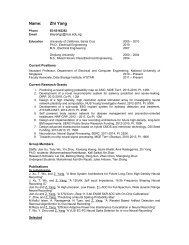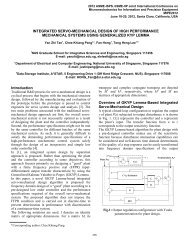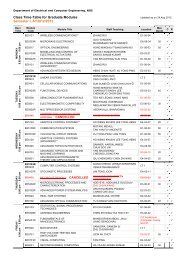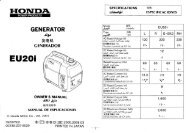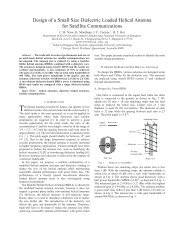Development and evolution of MOEMS technology in variable ...
Development and evolution of MOEMS technology in variable ...
Development and evolution of MOEMS technology in variable ...
You also want an ePaper? Increase the reach of your titles
YUMPU automatically turns print PDFs into web optimized ePapers that Google loves.
Lee <strong>and</strong> Yeh: <strong>Development</strong> <strong>and</strong> <strong>evolution</strong> <strong>of</strong> <strong>MOEMS</strong> <strong>technology</strong>…<br />
from one channel to the other, while the optical signal<br />
power <strong>of</strong> certa<strong>in</strong> channels may need to be attenuated at<br />
nodes as well. Currently, the dynamic ga<strong>in</strong> equalizer<br />
DGE 12,13 is provided <strong>in</strong> conjunction with the wavelengthdivision<br />
multi/demultiplexers MUX/DEMUXs to perform<br />
the attenuation function <strong>and</strong> the function <strong>of</strong> reconfigurable<br />
<strong>and</strong> transparent add/drop at nodes. The multichanneled<br />
VOA device can be the channel-power equalizer <strong>in</strong> WDM<br />
cross-connect nodes <strong>and</strong> <strong>in</strong> transmission networks. Thus,<br />
the <strong>in</strong>tegrated multichannel VOAs with MUX/DEMUXs<br />
will be an alternative to fulfill this market. In view <strong>of</strong> market<br />
requirements such as a small footpr<strong>in</strong>t <strong>and</strong> low power<br />
consumption, an array structure conta<strong>in</strong><strong>in</strong>g multiple MEMS<br />
attenuators <strong>in</strong> a s<strong>in</strong>gle silicon chip is preferable for future<br />
DWDM applications, while s<strong>in</strong>gle-port VOA is dem<strong>and</strong>ed<br />
<strong>in</strong> MAN applications.<br />
2 <strong>MOEMS</strong>-Based Attenuation Schemes <strong>and</strong><br />
Early <strong>Development</strong> Works<br />
The early development <strong>of</strong> VOAs <strong>in</strong> the late 1990s was<br />
ma<strong>in</strong>ly performed by two groups at Lucent Technology <strong>and</strong><br />
the group <strong>of</strong> Pr<strong>of</strong>. de Rooij at the University <strong>of</strong> Neuchâtel,<br />
Switzerl<strong>and</strong>. In 1994, Walker et al. developed a mechanical<br />
antireflection switch MARS device. 14 MARS comprises a<br />
suspended membrane with an optical w<strong>in</strong>dow at the center<br />
<strong>of</strong> the membrane. By actuat<strong>in</strong>g the membrane with a displacement<br />
<strong>of</strong> /4, the light <strong>of</strong> a particular wavelength<br />
could be either transmitt<strong>in</strong>g or reflect<strong>in</strong>g. The orig<strong>in</strong>al idea<br />
was to use MARS as an optical modulator for switch<strong>in</strong>g<br />
functions <strong>in</strong> fiber-to-the-home applications. In 1998, Ford<br />
et al. further revised the MARS structure <strong>and</strong> applied it to<br />
the VOA application. This MARS is a silicon-nitridesuspended<br />
membrane with /4 optical thickness above a<br />
silicon substrate with a fixed 3/4 spac<strong>in</strong>g. Voltage applied<br />
to electrodes on top <strong>of</strong> the membrane creates an electrostatic<br />
force <strong>and</strong> pulls the membrane closer to the substrate,<br />
while the membrane tension provides a l<strong>in</strong>ear restor<strong>in</strong>g<br />
force. When the membrane gap is reduced to /2, the layer<br />
becomes an antireflection coat<strong>in</strong>g with close to zero reflectivity.<br />
Basically, it is a quarter-wave dielectric antireflection<br />
coat<strong>in</strong>g suspended above a silicon substrate. 15 The membrane<br />
size varies from 100–500 m <strong>in</strong> diameter. The mechanical<br />
resonance frequency <strong>of</strong> such a MARS device is on<br />
the order <strong>of</strong> megahertz. Thus, the response time is extremely<br />
fast, i.e., 3 s. The dynamic range <strong>of</strong> attenuation is<br />
25 dB. However, the <strong>in</strong>sertion loss is 2 dB <strong>and</strong> wavelengthdependent<br />
loss WDL is relatively high for attenuation<br />
larger than 5 dB. Ford <strong>and</strong> Walker have further applied the<br />
concept <strong>of</strong> MARS to a MEMS-based DGE filter. To form<br />
the DGE filter, the optical w<strong>in</strong>dow <strong>of</strong> the attenuator was<br />
elongated to form a suspended rectangular membrane. An<br />
array <strong>of</strong> strip-electrode pairs along the length <strong>of</strong> the optical<br />
w<strong>in</strong>dow was arranged. By apply<strong>in</strong>g <strong>in</strong>dependently controlled<br />
voltages to all the electrode pairs, a controllable<br />
reflectivity function was developed along the length <strong>of</strong> the<br />
device. The diffraction grat<strong>in</strong>g-based, free-space optics system<br />
was used to spread the <strong>in</strong>com<strong>in</strong>g light spectrum spatially<br />
along the length <strong>of</strong> the optical w<strong>in</strong>dow. An <strong>in</strong>put<br />
spectrum with more than a 15-dB dynamic range was flattened<br />
to less than a 0.25-dB ripple over a 42-nm wide<br />
spectrum. 12<br />
In contrast to the suspended dielectric antireflection<br />
membrane used <strong>in</strong> MARS, Bishop et al. lead another team<br />
at Lucent Technology <strong>in</strong> 1998 to develop a MEMS VOA<br />
us<strong>in</strong>g a surface-micromach<strong>in</strong>ed polysilicon microshutter arranged<br />
between a transmission fiber <strong>and</strong> a reception fiber<br />
aligned <strong>and</strong> located on the same axis. 16,17 In this fiber-t<strong>of</strong>iber<br />
<strong>in</strong>-l<strong>in</strong>e type VOA, the shutter is connected with a<br />
movable capacitor plate via the pivoted rigid level arm, <strong>and</strong><br />
this shutter can move upward <strong>and</strong> downward <strong>in</strong> an out-<strong>of</strong>plane<br />
direction by adjust<strong>in</strong>g the position <strong>of</strong> the capacitor<br />
plate us<strong>in</strong>g electrostatic force accord<strong>in</strong>g to the applied voltage.<br />
Thereby, it can control a relative amount <strong>of</strong> attenuation<br />
by block<strong>in</strong>g parts <strong>of</strong> the light beams. This surfacemicromach<strong>in</strong>ed<br />
<strong>in</strong>-l<strong>in</strong>e type MEMS VOA can achieve a dynamic<br />
range as high as 50 dB, with less than 1-dB <strong>in</strong>sertion<br />
loss, while the reported shutter displacement can reach<br />
15 m under 3–25 V dc load. More details <strong>of</strong> these activities<br />
can be referred to <strong>in</strong> a review article by Walker. 1<br />
In addition to the surface-micromach<strong>in</strong>ed polysiliconbased<br />
approach, deep reactive ion etch<strong>in</strong>g DRIE <strong>technology</strong><br />
is another major alternative for mak<strong>in</strong>g MEMS VOA<br />
structures from device layers <strong>of</strong> a silicon-on-<strong>in</strong>sulator SOI<br />
wafer. The first demonstration was done by Pr<strong>of</strong>. de Rooji’s<br />
group at the University <strong>of</strong> Neuchâtel, Switzerl<strong>and</strong>, <strong>in</strong><br />
1998. 18 This SOI-based VOA device comprises a movable<br />
comb f<strong>in</strong>ger electrode connected with a microshutter via a<br />
suspended spr<strong>in</strong>g <strong>and</strong> a stationary comb-f<strong>in</strong>ger electrode.<br />
The attenuation range is determ<strong>in</strong>ed <strong>in</strong> terms <strong>of</strong> the <strong>in</strong>-plane<br />
position <strong>of</strong> the Si microshutter, where this <strong>in</strong>-plane position<br />
is controlled via force balance between electrostatic force<br />
<strong>and</strong> spr<strong>in</strong>g force. To reduce the return loss <strong>of</strong> the <strong>in</strong>put light<br />
reflected back <strong>in</strong>to the <strong>in</strong>put fiber, the microshutter <strong>and</strong> the<br />
fiber end faces are at an 82 deg angle with respect to the<br />
longitud<strong>in</strong>al direction <strong>of</strong> the fiber channels. This <strong>in</strong>-l<strong>in</strong>etype<br />
VOA achieved <strong>in</strong>sertion loss <strong>and</strong> back-reflection loss<br />
less than 1.5 dB <strong>and</strong> −37 dB, respectively, while it provided<br />
57-dB attenuation with respect to a 32-V bias. Apparently,<br />
among these early demonstrations, the movable<br />
microshutter-based approaches exhibit promis<strong>in</strong>g device<br />
features, e.g., a larger dynamic range. DRIE-derived SOI<br />
MEMS VOAs have silicon trenches to accommodate optical<br />
fibers with photolithography-process-determ<strong>in</strong>ed alignment<br />
accuracy relative to the microshutter. This feature<br />
makes the tedious assembly <strong>and</strong> alignment easier.<br />
3 Evolution <strong>in</strong> Surface-Micromach<strong>in</strong>ed<br />
Mechanisms <strong>and</strong> Attenuation Schemes<br />
Polycrystall<strong>in</strong>e-silicon-based surface micromach<strong>in</strong><strong>in</strong>g was<br />
<strong>in</strong>itially developed for accelerometers <strong>in</strong> the early 1990s.<br />
Surface-micromach<strong>in</strong>ed electrostatic parallel-plate actuators,<br />
electrostatic comb actuators, electrostatic scratch drive<br />
actuators SDA, U-shaped thermal actuators, <strong>and</strong> microstructures<br />
such as h<strong>in</strong>ges <strong>and</strong> latches were demonstrated <strong>in</strong><br />
early 1990s as well. These actuators <strong>and</strong> micromechanical<br />
elements enabled the realization <strong>of</strong> monolithically <strong>in</strong>tegrated<br />
free-space micro-optical benchs. 19,20 Essentially, the<br />
photon mass is not a physical concern, thus the surfacemicromach<strong>in</strong>ed<br />
actuator just needs to manipulate the small<br />
micro-optics or micromirrors. The MARS devices <strong>of</strong> Lucent<br />
Technology relied on an electrostatic parallel-plate<br />
type <strong>of</strong> actuation, 14,15 while the first <strong>in</strong>-l<strong>in</strong>e-type MEMS<br />
VOA from Lucent Technology deployed a revised micro-<br />
J. Micro/Nanolith. MEMS <strong>MOEMS</strong> 021003-2<br />
Apr–Jun 2008/Vol. 72




